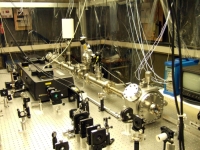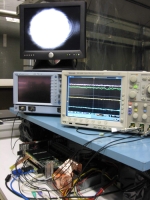 |
 |
|||||||||||||
|
|||||||||||||
|
|||||||||||||
|
Producing intense polarised positrons for the ILC is very challenging. Stability, energy, luminosity are the key words. Parallel to the baseline studies on a helical undulator-based source (see Newsline from 19 October 2006), other groups, like the laser group at LAL (IN2P3/CNRS), Orsay (France), pursue R&D on a Compton positron source. The Orsay team recently measured an unprecedented enhancement factor of the pulsed laser beam inside their Fabry-Perot cavity. They expect bigger factors in a few months.
In a Compton positron source, a pulsed-laser beam is sent on electron bunches, so that they emit powerful photons -X rays- which convert into pairs of polarised electrons and positrons on a tungsten target. The principle has already been tested at KEK at the ATF Facility (see papers published in March 2006 and October 2003). For the ILC, only an optical resonator - a Fabry-Perot cavity - can produce a powerful enough pulsed laser. More than ten researchers and engineers, constituting the LAL laser group, investigate to understand which maximum gain they could obtain with a picosecond-pulsed laser beam. They have manufactured their own cavity with two highly reflective mirrors. Recently, they obtained a very high gain of 1200. The average input power was about 1 watt - the power inside the cavity was thus about 1 kilowatt. Within the coming months, they expect new mirrors, produced at the 'Laboratoire des Matériaux Avancés' (CNRS) in Lyon who are already working for the VIRGO interferometer, and they think they could gain a factor 10 and 100. This high gain was very difficult to obtain on a pulsed laser. The frequency repetition rate of the laser pulses is 75 MHz and to obtain this high gain, they needed to control this frequency at a relative precision of roughly 10-10, which represents a precision of about 75 mHz. They obtained this precision with a new kind of digital feedback system, while traditional feedback systems are analogical. It allows a fine response to error signals, and is also able to take into account more than one degree of freedom as required for higher enhancement factors. The Fabry-Perot cavity tuning then proved to be quicker and more flexible. The power gain the group obtained this way was never reached before, under the same specific experimental conditions. Fabian Zomer, who supervises the laser group, presented this work last week at the Photon 2007 conference in Paris. “This work would never have been possible without the strong and dynamic technical support of the mechanics and electronics engineers at LAL,” Zomer said. For these studies, the LAL group works in close collaboration with KEK, notably in the framework of the France-Japan Particle Physics Laboratory. The work of the two teams is complementary. At KEK, the group has installed a two-mirror cavity of lower gain in the ATF facility. Their aim is to enhance the Compton X-ray flux and to soon notably enhance their mean power. They also study real background conditions which could not be measured at LAL installations. In France, the Orsay team also works on four-mirror cavities with a more powerful pulsed laser. A new prototype will be installed in between 2008 and 2009 at ATF. The LAL studies are supported by the European Commission within EUROTeV. In autumn 2007, the group expects to enhance the power of their laser source, thanks to additional funding from IN2P3/CNRS and the Ile de France region. They also want to look at possible uses of this high-power monochromatic photon (X-ray) source for cancer therapies. -- Perrine Royole-Degieux |
|||||||||||||
| © International Linear Collider |



